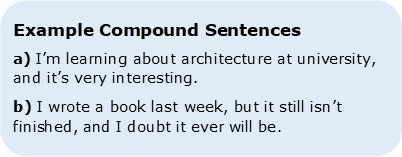How can I form accurate compound sentences?

This is the third and final chapter about Simple and Compound Sentences. To complete this reader, read each chapter carefully and then unlock and complete our materials to check your understanding.
– Focus specifically on the compound sentence structure
– Provide four useful rules for writing compound sentences accurately and grammatically
– Include examples of each rule to help guide the reader
Before you begin reading...
-
video and audio texts
-
knowledge checks and quizzes
-
skills practices, tasks and assignments
Chapter 3
While Chapter 2 focused specifically on identifying simple sentences, this third and final chapter explores the forms and rules of compound sentences such as ‘I like studying, but he doesn’t’. Because compound sentences such as this are probably one of the most common of the four sentence structures, it’s important that students understand how to use and recognise this sentence type with accuracy – particularly in academic writing. Much like the rules for simple sentences, the following four rules should be followed at all times if you wish to correctly use compound sentences in your written assignments.
Rule 1: Use Only Independent Clauses
Like simple sentences, compound sentences are made of only independent clauses that have a subject and a verb and can stand alone as complete thoughts and sentences. One clear signal of a compound sentence is the use of coordinate conjunctions such as ‘and’ or ‘but’ to join these clauses. If, however, the sentence in question contains a subordinating conjunction such as ‘because’ or ‘even though’, it therefore contains a dependent clause and is not a compounded structure.

Rule 2: Use Two or More Independent Clauses
Unlike simple sentences however, compound sentences require two or more independent clauses to be considered compound. The following examples have been provided to demonstrate compound structures that use two or more independent clauses:

In these examples, we can see that the compound sentence (a) has two independent clauses joined with a comma (,) and the coordinate conjunction ‘and’, while the compound sentence in (b) has three independent clauses joined with commas and the conjunctions ‘but’ and ‘and’. For compound sentences like these, there’s grammatically no limit as to how many independent clauses can be joined in this way; however, any more than three independent clauses in one sentence does tend to become difficult for readers to understand.
Rule 3: Join Independent Clauses Correctly
It’s critical that students learn to join their independent clauses correctly when creating compound sentences, otherwise they may find themselves with ungrammatical run-on sentences, comma splices and sentence fragments. The general and most commonly used rule is that every independent clause should be joined with both a comma (,) and a coordinating conjunction (and, so, but, etc.), as was shown in the previous examples.
However, there may be times when the writer wishes to show a closer connection between two independent clauses by instead joining these clauses with a semi-colon (;), which is also perfectly grammatical in compound sentences:

What’s not grammatical is joining two independent clauses with only a comma as doing so creates an ungrammatical comma splice – a type of sentence run-on:

Rule 4: Avoid General Compounding
One final aspect to watch out for is that students don’t become confused between the general compounding of sentence elements such as noun phrases and the conjoining of two or more independent clauses. Such confusion is likely to occur because both structures tend to use coordinating conjunctions such as ‘and’ to join their elements. As the following examples show, incorrect identification of these constructions could lead to students using incorrect punctuation or conjunctions and therefore creating ungrammatical structures:


Notice in example (b) that the two nouns ‘architecture’ and ‘engineering’ have been incorrectly separated by a comma (,) when that comma should in fact be placed before the second ‘and’ conjunction and not the first. This is because it is the second conjunction that signals the conjoining of the two independent clauses that make the grammatical compound sentence in (a).
Good work on finishing this short reader on simple and compound sentences. After completing the Chapter 3 activities to check your understanding, you may then wish to continue with this topic by studying our short reader on compound-complex sentences that deals with both complex and compound-complex sentence structures.
Downloadables
Once you’ve completed all three chapters in this short reader about Simple and Compound Sentences, you might then wish to download our Chapter Worksheets to check your progress or print for your students. These professional PDF worksheets can be easily accessed for only a few Academic Marks.
Chapter 1 explores the topic: How can I better understand sentence structures? Our Chapter 1 Worksheet (containing guidance, activities and answer keys) can be accessed here at the click of a button.
Chapter 2 explores the topic: What is a simple sentence in English grammar? Our Chapter 2 Worksheet (containing guidance, activities and answer keys) can be accessed here at the click of a button.
Chapter 3 explores the topic: How can I form accurate compound sentences? Our Chapter 3 Worksheet (containing guidance, activities and answer keys) can be accessed here at the click of a button.
To save yourself 2 Marks, click on the button below to gain unlimited access to all of our Simple and Compound Sentences Chapter Worksheets. This All-in-1 Pack includes every chapter, activity and answer key related to this topic in one handy and professional PDF.
Collect Academic Marks
-
100 Marks for joining
-
25 Marks for daily e-learning
-
100-200 for feedback/testimonials
-
100-500 for referring your colleages/friends